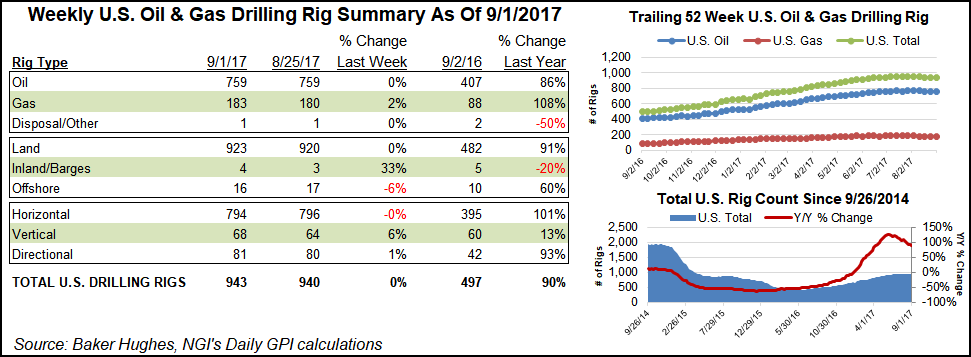Harvey’s Rig Count Impact Uncertain; U.S. Adds Three NatGas Units
Quantifying Hurricane Harvey’s full impact on South Texas remains a challenge, which extended to Baker Hughes Inc.’s (BHI) weekly rig count Friday.

For the week ended Sept. 1, the oilfield services giant said Harvey’s impact prevented a full accounting of rigs in South Texas, home to the Eagle Ford Shale. BHI said it could only verify one change for the week across 47 storm-affected counties, a lone rig that departed in Dimmit County. As a result, BHI’s South Texas tally — likely to change as the region continues to take stock after Harvey — largely carried over from the prior week.
It was a week in which the oil and gas industry came together to help employees and support relief efforts in the aftermath of the devastating flooding in Houston. While business came second to addressing the immediate needs of flood victims, operations continued across the country, and U.S. drillers added three rigs — all natural gas-directed — for the week, according to BHI’s figures.
In the United States, gas-directed rigs finished at 183, while oil-directed rigs held at 759 for the week, putting the U.S. rig count at 943 versus 497 a year ago. The United States added one directional rig and four vertical units, with two horizontal units departing, BHI said. One rig left in the Gulf of Mexico as three land rigs returned.
Canada dropped 13 oil-directed rigs and three gas-directed to finish at 201 rigs, down 16 week/week but up from 137 a year ago. That left the North American rig count at 1,144, down 13 week/week and up from 634 in the year-ago period.

Among plays, the Permian Basin added three rigs to end at 380 versus 202 running a year ago. The new Permian units apparently all went to work in New Mexico, which also finished up three rigs week/week.
In the Midcontinent, the Cana Woodford dropped four rigs week/week to end at 65, while the Arkoma Woodford and Granite Wash each added one rig.
After a coming-out party last week, in which the Haynesville Shale officially announced its return to form as a threat to the Marcellus Shale’s natural gas dominance, the North Louisiana/East Texas play receded a bit, dropping two rigs to finish at 44 (versus 14 a year ago). That put the Haynesville level with the Marcellus, which added a rig to finish the week at 44 (versus 27 a year ago).
As for the Eagle Ford, the process of assessing the damage from Harvey continues.
“We could not verify the change in rig counts across 47 counties in South Texas, with the exception of one rig moving out of Dimmit County,” BHI said. “Therefore, we’re reporting the same counts as last week minus the one rig that has been accounted for, totaling 87 rigs across the 47 counties.”
That left the Eagle Ford at 73 rigs for the week by BHI’s count. But analyst estimates suggest Harvey’s effects on the South Texas onshore have been much more pronounced.
According to Raymond James & Associates Inc. analyst J. Marshall Adkins, more than half of the rigs running in the Eagle Ford Shale suspended drilling ahead of the storm. Muddy conditions also may hinder a quick return to work.
“Given that much of oil and gas activity occurs in areas only accessible via dirt roads, the heavy rainfall usually makes the movement of trucks and supplies much more difficult,” Adkins wrote. “The trucking and rail of sand, chemicals, and personnel to the well site will all take more time given the likely nasty condition of many Eagle Ford access roads.”
A temporary drop in the rig count by as much as 45 rigs because of flooding could be a catalyst for higher oil prices, he said.
Meanwhile, IHS Markit’s team of analysts said a key issue for Eagle Ford producers “remains takeaway capacity, given that most of Houston-area refineries are still offline or at reduced capacity. The restart of Corpus Christi refineries, however, should be a positive in terms of returning Eagle Ford wells to production.”
© 2024 Natural Gas Intelligence. All rights reserved.
ISSN © 1532-1231 |
